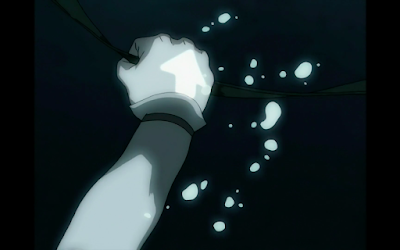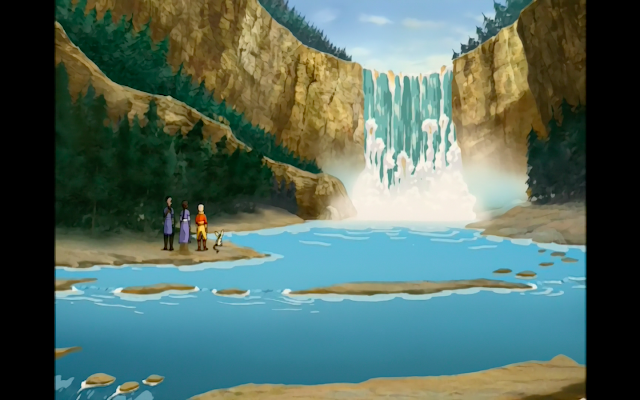The Storm: a Lesson in Parallel Storytelling
Like most effective visual entertainment such as plays, movies, or even magic tricks, The Storm is comprised of three acts. The first act introduces the characters as normal people, but hints at their flaws, fears, and mistakes. The second act explores those flaws through flashback scenes and other artistic imagery. The third act bring it all full circle into the present moment by challenging the characters and giving them the chance to set things right.
So far in the series, Zuko is seen as a cut-and-dry antagonist. Aang tries to fulfill his destiny as the Avatar, while Zuko always attempts to capture him. And that has been the extent of it... until now.
What makes The Storm so amazing, from a character development perspective, is that it shifts the ENTIRE SHOW over the course of one episode. How?! In just 22 minutes, ATLA transforms from a protagonist/antagonist story, to a dual protagonist story. Zuko is no longer just "a bad guy." Both Aang and Zuko's stories are given equal importance and are paralleled extremely well. Zuko is now what's known as the Deuteragonist, or 2nd main character.
Parallel is the key word here. Yes, many series have fleshed-out villains, but what sets this distinctly apart is the use of parallel storytelling. I hope I can convey these ideas well enough over the course of this blog, because what this episode accomplishes is just mind-boggling.
So without further ado, welcome to the 1st act of The Storm, the Introduction.
Doesn't every good story start with a dream? Dreams are important because they have the uncanny ability to surface even our deepest emotions. Our delights and aspirations... as well as our fears.
No one saw that, did they? Nope, me neither. ;)
It's amazing how lightning is used as a theme for this episode. Yes, the episode is called The Storm, and lightning is usually found in storms... but like everything else in this episode, the theme is deeper than it first seems. For instance, Firelord Ozai's silhouette flashes on screen over lightning. Is it just a scare tactic? Oh no, this is foreshadowing at its best. In addition, lightning is used in many key transitions throughout The Storm (more on that later), and Uncle Iroh redirects lightning like a complete badass. It's just astounding how many ways that lightning is expertly used to convey emotion, build tension, and transition scenes. It's like the storm is its own character...
Iroh senses the storm, possibly both because of the feeling in his joints and his observation of the birds overhead.
Zuko's story is set up well in this opening scene. His lack of respect and blindness from chasing the Avatar are front and center. Here we see Zuko act exactly like the boy his father thought he was. Zuko let his father's wishes control and consume him.
Aang's story is also set up well in the first act. The fisherman recognizes Aang as the Avatar, and blames him for turning his back on the world. Aang, visibly hurt by this comment, runs away to a cave in the hillside. Katara flies on Appa after him.
I don't know what it is about this wide, sweeping shot, but I thought it was well done:
To better show the parallels between the two stories, the pictures from here on out will not fall in chronological order.
The 2nd act of the episode begins now, when we explore the troubled pasts of our two protagonists:
1st Parallel: Both backstories are told over a campfire. During the transition to Zuko's backstory, he is seen emerging from the flames of Iroh's fire.
The War Room:
Here, Zuko is a young man of unquestionable honor. It's now apparent that over the last few years, he has lost his way.
Notice that when Zuko speaks, the Firelord is framed behind him.
Yeah, I don't need to explain this wonderful imagery. It's too good...
Now on to Aang's story. The inspiration for the Avatar came in part from the Dalai Lama. There are a couple of key points to realize: 1st, the name of the current Dalai Lama is Tenzin Gyatso. Monk Gyatso is Aang's guardian, and (is this a spoiler?) Aang's son in the follow up series The Legend of Korra is named Tenzin. 2nd, the toy relics pay direct homage to how the Dalai Lama is chosen. I'm not sure of the details, but it is similar. Also, the idea of past lives is explored further as the series progresses.
2nd parallel: Both Aang and Zuko's mentors sensed a storm was coming. In Uncle Iroh's case, he sensed a literal storm, but in Gyatso's case, the storm was metaphorical. "There are troubling signs. Storm clouds are gathering," he tells Aang. He knew the war was on the Air Nomads' doorstep.
3rd parallel: Just like Zuko, Aang was banished for being different. After finding out about his Avatar powers, the other children treated Aang like an outcast, and shortly thereafter, he was "banished" from the southern air temple completely.
Zuko was the only person in that war room with a heart, but his father mistook it for weakness. Zuko's "weakness" was the reason for his banishment, while Aang's unwanted strength was the reason for his.
4th parallel: Both mentors loved Pai Sho! And both had a great sense of humor.
The head monk counters, "But what we need is what's best for the world."
Interesting dynamic there.
You know the story, Aang runs away and freezes himself in the iceberg (as a defense mechanism) during a terrible storm.
Now coming back to the present moment, Aang furiously yells, "How could they do that to me? They wanted to take away everything I knew and everyone I loved!" The voice acting is great (that goes for the whole episode).
"The world needs you now. You give people hope."
Back to Zuko's story: Damn, this is tragic. Because Zuko refuses to fight his father, he is seen as weak and shameful. We witness the fall of a rising prince.
I'm sure you know this, but Mark Hamill voices Firelord Ozai! He is known for his portrayal of Luke Skywalker in Star Wars and for his iconic role as The Joker in the Batman animated series.
"Suffering will be your teacher." Ozai then proceeds to burn half of his own son's face off. Yeah...
Just thought you'd appreciate this shot.
Iroh cannot bear to witness his nephew's pain. Zuko's scream is just plain chilling.
Iroh concludes his masterful tale of Zuko's backstory with this: "But the important thing is, the Avatar gives Zuko hope."
Can we take a moment to appreciate this sequence? Holy cow, this hit me in the feels. Just to jog your memory, we hear the muffled and echoed sound of a child's playful scream. Additionally, this is the first appearance of a certain musical theme which returns for other key emotional moments throughout the series such as this:
This tragic backstory is made all too real when they show how his face has changed. His scar isn't the most horrifying part; it's the emotional baggage and stress that has warped his face. No doubt about it, his banishment irreversibly changed him. I'd love to delve deeper into that, but no spoilers! :)
Lightning bolts provide a shocking transition from the past to the present, electrifying the air as the episode's 3rd act comes in to play.
And again, the theme of lightning returns! The best Uncle on Earth redirects lighting in order to save his crew! See, many shows may contain badass moments like this, but they are usually self contained and used only for visual entertainment. Needless to say, this is not the case here. After multiple rewatches, you realize how important and magnificent this small scene actually is.
This 3rd act focuses on the present and how our two protagonists overcome their flaws. This act should be called Redemption.
5th parallel: Both Aang and Zuko act to redeem themselves. Zuko saves the helmsman and guides the ship to safety, and in doing so, restores honor and order on the ship.
Used as a clever parallel for overcoming and escaping the iceberg, Aang redeems himself by saving Sokka and the fisherman from the violent storm.
"I'm too young to die!" yells Sokka.
The fisherman shouts back, "I'm not, but I still don't wanna!"
God, I love that line!

Aang's redemption. It looked like he was going to encase everyone in ice, but instead he created a giant underwater air scooter to get everyone to safety. This visual mirroring of his previous failure made for quite a triumphant moment.
As the Gaang exits the ocean, they happen to cross paths with Zuko. "The Look" between Aang and Zuko says so much... it shows that they may be starting to understand and respect eachother more. They both narrowly escaped a great loss... at the end of the day, family is most important.
I find it extremely poetic that both parties converge at the eye of the storm. So well done.
In the final scene, Aang decides that he's done dwelling on the past.
"I'm here now, and I'm going to make the most of it," says Aang. Does that sentiment sound familiar? Let's see if you can recognize this: "We must not concern ourselves with what was, we must act on what is." Well, that is a quote from Monk Gyatso in episode 3, The Southern Air Temple. I love that Aang is still applying this wisdom several episodes down the line. It adds so much depth and appeal to the story.
Katara concludes, "I don't think you're going to have those nightmares anymore."
The storm has finally passed.
Conclusion: The Storm is absolutely dripping in metaphors, visual storytelling techniques, parallels, and subtext... It's a joy to watch and far surpasses any other "kid's show" I've seen. I would rank this among the best TV episodes ever made, period, for its storytelling prowess. Simple, yet extremely deep and effective.
Does The Storm have intense action scenes? No. Is it visually astounding? No, especially when compared to other anime or Avatar's very own Books 2 and 3. Is it a funny episode that will capture people's hearts with charm? Definitely NOT!
But make no mistake, The Storm is a masterpiece. Every time I watch it, I am able to pick up something new.
I proudly rate The Storm a 10/10.
Thank you so much for reading, and until next time, peace.













































Comments
Post a Comment